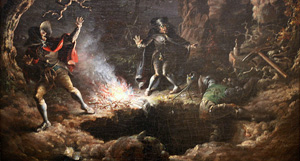 Gambling is not a common topic of academic research and people sometimes ask me why I choose to specialize in gambling studies. Here is the story of how it started.
Gambling is not a common topic of academic research and people sometimes ask me why I choose to specialize in gambling studies. Here is the story of how it started.
Back in 1997 I had completed my doctoral thesis, in which I explore and analyze notions of life-force and transcendence in traditional Southern Italy. One of many topics in the thesis was legends about the origins of the relics, images and statues of locally venerated saints. These legends typically tell that the holy object was found by a pure-hearted individual in a cave or buried in field. The object is then brought to the community church, where it currently is identified with the saint itself, fervently venerated, and believed to bring blessings to everyone.
In the Italian folkloristic sources I also found many legends about enchanted golden treasures. These legends were, structurally speaking, the inverse of the legends of saints. The treasure is hidden underground and guarded by demons or the devil. Greedy and selfish individuals try to break the magical spell that protects the treasure, often by performing obscene rituals or making human sacrifices. However, they nearly always make some mistake in the final phase of breaking the spell and are punished by horrible afflictions or death. The golden treasure remains buried in the ground, awaiting the next wicked and greedy individual to make a try on breaking the spell.
Thus, a bipolar structure emerges when the two kinds of legends are compared. Saints (in the form of their relics and images) and treasures are two very valuable things that can be found buried underground. While the former is associated with divinity, blessings, altruism, morality and life-force, the latter is associated with the devil, disaster, greed, depravity and death.
Many people in Southern Italy fully believed that the mythological golden treasures existed for real and tried to find them. This was especially in times of crop failure and deep poverty. Divining rods and “magnetic balls” were used to locate the treasures, and then the treasure hunters began the ritual of breaking the magical spell. Several court cases that attracted much attention in Southern Italy in the 19th century concerned treasure hunters who had committed ritual murder or rape in order to disenchant treasures (Amalfi, 1914: 190-195; Arena-Capaci, 1897). One criminological source informs that in 1894, 44 children were murdered in Sicily in connection with treasure hunting (Gross 1922: 483). Similar treasure hunting obsessions have occurred elsewhere, for example in North America in the period 1780-1830 (Taylor, 1986). People living in misery on poor farms left everything behind and went treasure hunting in the wilderness in the hope of finding a golden treasure that would make them rich and happy. In anthropology, such phenomena are called “millenarianism” – a sudden breakdown of traditional life and economy in which people believe that money and wealth soon will emerge in great quantities, for all to have and without the need to work (e.g. Worsley, 1968).
I tried to get funding for a study of treasure legends and treasure hunting in Southern Italy, but the research council was unresponsive. Perhaps the topic was considered to be a bit odd. I reflected on how to approach the theme of money, wealth, morality and symbolism from an angle that would be perceived as more relevant to our current time and society. And it was then I thought about gambling. There are obvious similarities between treasure mythology and gambling. Sudden wealth is surrounded by moral ambiguity. Wealth may be represented as either a blessing or a curse. There are symbols of affluence, rituals of appropriation, and beliefs in luck and the supernatural. Is good luck a secular form of divine graze? Can gambling be seen as low-intensity millenarianism?
Together with a colleague, I got funding for a study of the symbolism and morality of gambling. The study included both theoretical work and field studies of gambling in Sweden. It resulted in seven academic papers. One of these papers presents a media study of what the tabloid press writes about big lottery wins. I identified several of the general moralistic themes that I had found in the South Italian legends of saints and enchanted treasures, which closed the circle.
I have now studied gambling since 2001 and have no plans to take an interest in any other academic topics. Gambling studies is a multidisciplinary field in which you always can find something new and interesting to do.
References
Amalfi, G., 1914. Delitti di superstizione. Rivista di diritto penale e sociologia criminale 15: 137-229.
Arena-Capici, P., 1897. Rapimento di bambini in Messina per tesori incantati. Archivio per lo studio delle tradizioni popolari 16: 441-2.
Gross, H., 1922. Handbuch für Untersuchungsrichter als System der Kriminalistik. (7 ed.) München, Berlin und Leipzig: J Schwitzer Verlag.
Taylor, A., 1986. The Early Republic’s supernatural economy: Treasure seeking in the American Northeast, 1780-1830. American Quarterly 38: 6-34.
Worsley, P. 1968. The Trumpet Shall Sound: A Study of “Cargo” Cults in Melanesia. New York: Schocken Books.

